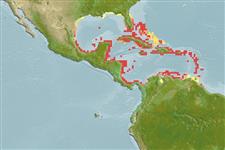Environment: milieu / climate zone / depth range / distribution range
Οικολογία
Θαλασσινό(ά) Υφαλόφιλο(α); μη μεταναστευτικό(ά); εύρος βάθους 0 - 3 m (Ref. 7247). Tropical; 32°N - 8°N, 98°W - 59°W
Western Central Atlantic: Florida, Gulf of Mexico, Caribbean Sea and along the coast of central America to Panama and Venezuela. Also known from the Bahamas and the Antilles.
Μέγεθος / Βάρος / Age
Maturity: Lm ? range ? - ? cm
Max length : 15.0 cm TL αρσενικό/απροσδιόριστο; (Ref. 26340)
Short description
Κλείδες προσδιορισμού | Μορφολογία | Μορφομετρία
Ραχιαίες άκανθες (συνολικά) : 12; Μαλακές ραχιαίες ακτίνες (συνολικά) : 14 - 17; Εδρικές άκανθες: 2; Μαλακές εδρικές ακτίνες: 13 - 15. Juveniles are reddish orange above, with small bright blue spots on forehead and dark spots at upper pectoral fin base, dorsal fin, and caudal peduncle; colors disappear as fish grows larger (Ref. 26938). Adults dark gray to blackish with vertical black lines on body; a black spot, sometimes diffuse, at upper base of pectoral fins which are pale; other fins dark (Ref. 13442).
Adults inhabit rocky shores exposed to wave action. Often in tide pools. Feed primarily on algae and detritus. Territorial and pugnacious. Generally common (Ref. 9710). Oviparous, distinct pairing during breeding (Ref. 205). Eggs are demersal and adhere to the substrate (Ref. 205). Males guard and aerate the eggs (Ref. 205). Taken incidentally in traps and small-meshed beach nets (Ref. 5217).
Life cycle and mating behavior
Γεννητική Ωρίμανση | Αναπαραγωγή | Γεννοβολία | Αβγά | Γονιμότητα | Προνύμφες
Oviparous, distinct pairing during breeding (Ref. 205). Eggs are demersal and adhere to the substrate (Ref. 205). Males guard and aerate the eggs (Ref. 205).
Allen, G.R., 1991. Damselfishes of the world. Mergus Publishers, Melle, Germany. 271 p. (Ref. 7247)
IUCN Red List Status (Ref. 130435: Version 2024-1)
Threat to humans
Harmless
Human uses
αλιεία: Εμπορικό(ά); Ενυδρείο: Εμπορικό(ά)
Εργαλεία
Special reports
Download XML
Διαδικτυακές πηγές
Estimates based on models
Preferred temperature (Ref.
123201): 26.2 - 28.3, mean 27.5 °C (based on 449 cells).
Phylogenetic diversity index (Ref.
82804): PD
50 = 0.5000 [Uniqueness, from 0.5 = low to 2.0 = high].
Bayesian length-weight: a=0.02089 (0.00953 - 0.04582), b=2.98 (2.80 - 3.16), in cm total length, based on LWR estimates for this Genus-body shape (Ref.
93245).
Τροφικό Επίπεδο (Ref.
69278): 2.5 ±0.1 se; based on diet studies.
Ελαστικότητα (Ref.
120179): Υψηλό, ελάχιστος χρόνος για διπλασιασμό πληθυσμού < 15 μήνες (Preliminary K or Fecundity.).
Fishing Vulnerability (Ref.
59153): Low vulnerability (10 of 100).
Nutrients (Ref.
124155): Calcium = 105 [52, 172] mg/100g; Iron = 0.724 [0.421, 1.239] mg/100g; Protein = 18.3 [17.1, 19.5] %; Omega3 = 0.0847 [, ] g/100g; Selenium = 16.2 [8.4, 32.9] μg/100g; VitaminA = 79.7 [20.8, 291.8] μg/100g; Zinc = 1.79 [1.18, 2.71] mg/100g (wet weight);
